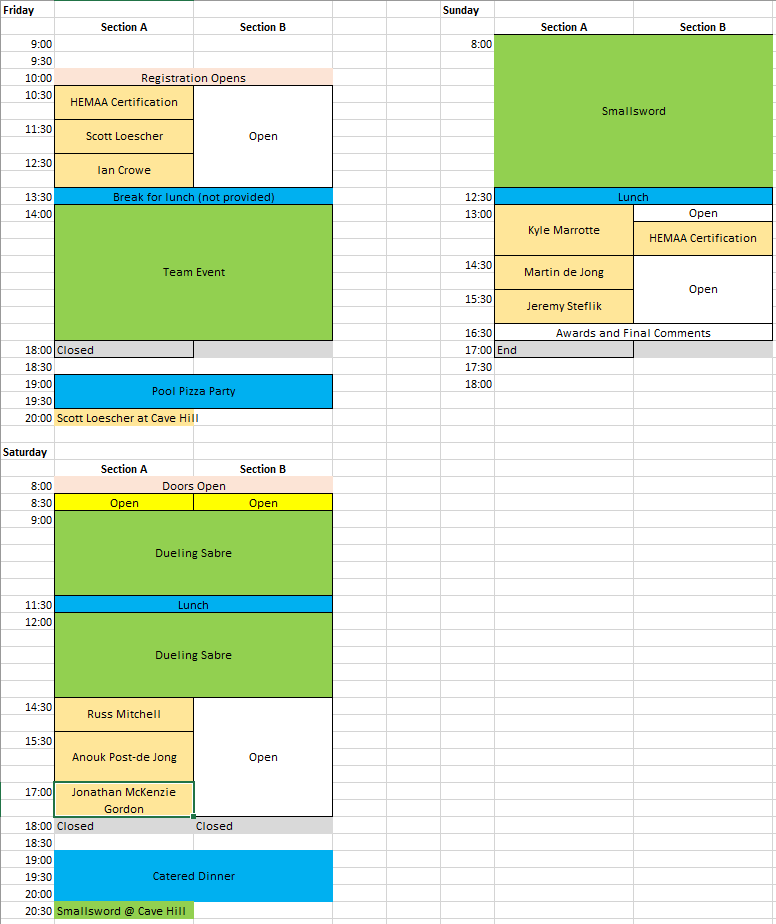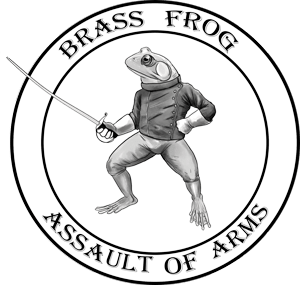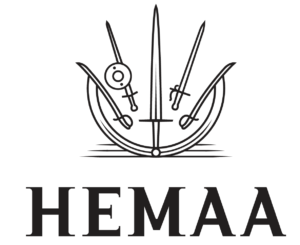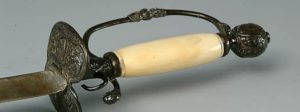Russ Mitchell
Scott Loescher
Jeremy Steflik
Kyle Marrotte
Ian Crowe
Martin de Jong
Anouk Post-de Jong
Jonathan MacKenzie Gordon
More to come!
Don’t Fragging Stop, Soldier: Fixing Artifacts in HEMA Sabre
Instructor: Ian Crowe
Contrary to what people may want to believe, HEMA has many, many artifacts in it that come about because it’s a sport. This class isn’t going to fix all of them, but it can try to fix one of them. Stopping. Think about your average pass. Fencers can have confidence that so long as they defend one afterblow attempt, they’ll probably win the pass. The problem is it’s easy to make a hit if one becomes immortal almost immediately after, and thus set up and control are far less important than reading any treatise would imply. Through the use of a drilling concept, this class will attempt to break that habit. And force you to read past page two of Roworth.
Operationalizing Ferdinand’s Broadsword Lessons
Instructor – Jonathan Gordon, Maryland KDF
Class Description – John Ferdinand was a fencing master based in Edinburgh, Scotland and published his Sword’s-Man pamphlet in 1788. Ferdinand’s twelve broadsword lessons are heavily influenced by Andrew Lonergan’s 1771 The Fencer’s Guide and are intended for students who are already familiar with the basics of measure, footwork, basic feints and combination attacks.
Class Goal – The goal of this class is to provide experienced fencers with launching points for dealing with a variety of scenarios and select lessons will be used as baselines to discuss successful decision making during a variety of scenarios, including tournament applications.
Requirements – Students will need a mask, gloves and a broadsword, saber or spadroon trainer and should have some familiarity with military saber and broadsword manuals.
Taming the Flying Mare: Reviving the lost art of Irish Collar and Elbow Wrestling
Instructor: Kyle Marrotte
Coiléar agus Uille, anglicized as Collar and Elbow, was arguably the most popular style of wrestling in Europe and the New England for almost the entirety of the 19th century. But, by the 20th century, the sport was already considered a dying art, and today in Modern Ireland, most have never even heard of it. What caused the popularity of this unique form of folk wrestling to skyrocket, and vanish into history nearly as quickly? In this class, we’ll take a look at this important-yet-forgotten part of Irish history, learn theorized recreations of some of the techniques, and engage in some free-sparring utilizing its modern ruleset.
Required equipment:
Mouthguard is highly recommended
Wrestling jacket. Limited quantities and sizes available to borrow. JF Ringen Jacket or Judo / BJJ Gi preferred; a fencing jacket can possibly be used at your own risk. If you truly have no jacket available, jacketless variants of techniques can be taught individually.
From Fencing Salle to Fo’c’sal: Will your fencing techniques keep you alive in a naval boarding action?
Instructor: Scott Loescher
Picture this: you are the child of a well-to-do family in England during the late 18th century. You’ve diligently studied the foil with your fencing teacher, and you might have even read a manual by Angelo or Roworth. So far, this probably sounds pretty similar to your HEMA training doesn’t it?
Well now your father tells you that you’re going to join the Royal Navy. Soon you find yourself gunwale to gunwale with an enemy ship. You left your foil at home, so you draw the spadroon or saber your father bought you if you’re lucky or a cutlass from the wrack if you weren’t, and you fight for your life!
Your training has been focused on dueling, but now you are faced with a wall of sailors ready to cut you down. Will the skills you learned in the salle save your life in a boarding action, or will your body be condemned to the deep wrapped in sailcloth with a 9lb cannonball between your feet? That’s what we’re going to find out!
Requirements: Steel saber/spadroon/cutlass trainer. Saber tournament gear from the waist up.
Instructor: Jeremy Steflik
The ability to think on your feet while fencing or fighting, to probe and analyze your opponent’s skills and tactics and to develop strategies to counter them, is what separates good fencers from great fencers. It’s a skill that needs to be developed and honed.
This class will explore drills and exercises to promote higher level thought while fencing, for beginners and advanced students alike.
We’ll be using sabers for this class (dueling or military) so please come equipped with appropriate gear.
Instructor: Russ Mitchell
Instructor: Anouk Post-de Jong
Explaining to the Americans why Colin is wrong (aka, the Spadroon is awesome)’
What a peculiar workshop title, you say. And I suppose that is true! But it is a workshop with a history.
As I transitioned from longsword to sabre, I was the only one in the Netherlands who was interested in Roworth sabre, so I reached out through Facebook to a fella named Colin Fieldhouse if you could answer ‘some’ questions regarding this British source. The result were hour long conversation and a new friendship.
The friendship took a dent when I discovered that the spadroon was not as terrible as some (read; Colin) had described to me, and he could hardly contain his disdain when he discovered I started to do more and more spadroon.
He was so full of disdain that he invited me to teach at his event to teach spadroon. Not once, but thrice! These workshops were a great success, and were called; ‘Why Colin is wrong’, ‘Why Colin is still wrong’ and ‘Proving once and for all why Colin is wrong.’
Of course this was all a jest, and our friendship was hardly affected by my preference for this peculiar military weapon, but in honor of this series of workshop I will now explain to you why the spadroon does not deserve the hate it has received for centuries and why in fact it is a rather fun weapon compared to the broadsword and sabre.
We will dive into the spadroon section of Roworth’s Art of Defence (1804), we will compare the spadroon to the broadsword and sabre, so that in the end you will be able to explain to Colin why he is wrong and discover why the spadroon is awesome.
Instructor: Martin de Jong
Assistant Instructor: Anouk Post-de Jong
In this workshop you will learn how to fight with a klewang as taught in the KNIL (Royal Netherlands East Indies Army) regulation from 1937. This iconic short type of sabre was used in close combat situations in the various environments of what is now present day Indonesia. You will learn basic movements with and without weapons, cuts, thrusts and parries with the klewang and how to use the carbine in the off-hand active and passively. We will practice this in solo and group exercises.
Did you know that the US Navy has a model similar to the klewang?
It is the P1917 US Navy cutlass.
Level: all levels.
Gear requirements: For the left hand a medium-heavy glove. For the right hand Red dragon glove and/or heavier. Fencing mask. Throat protector.. Full gear is optional when practicing. When sparring after class, full gear is required..
Weapons required: a pair of klewang and carbine trainers per each participant.
If you have your own trainers please bring them (no fencing rifles).
If you don’t have them, sabers, cutters and cutlasses (because of the length) (steel/synthetic) will also suffice. A couple of loaner klewangs will be provided.
HEMAA Instructor Certification Practical Exams
There will be several opportunities throughout the weekend for attendees who have started the HEMAA Instructor Certification Program process to complete the practical teaching portion of the program in person. Please contact instructorcertification@hemaalliance.com and Cc wstrinfo@gmail.com for scheduling.





